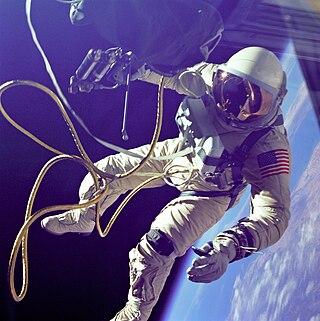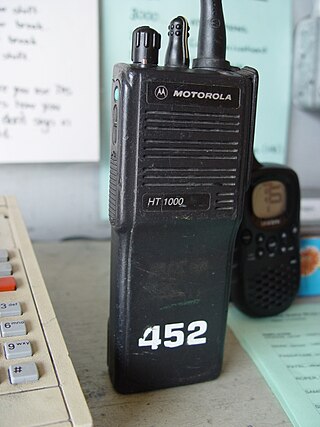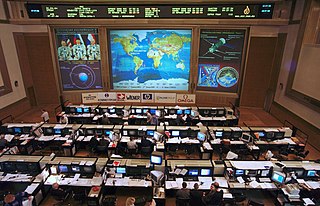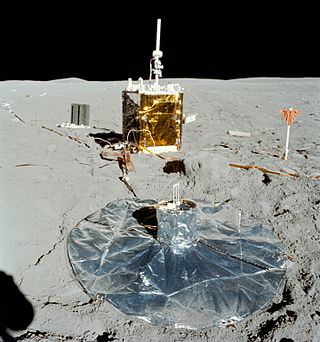
Apollo 7 was the first crewed flight in NASA's Apollo program, and saw the resumption of human spaceflight by the agency after the fire that had killed the three Apollo 1 astronauts during a launch rehearsal test on January 27, 1967. The Apollo 7 crew was commanded by Walter M. Schirra, with command module pilot Donn F. Eisele and lunar module pilot R. Walter Cunningham.

Apollo 12 was the sixth crewed flight in the United States Apollo program and the second to land on the Moon. It was launched on November 14, 1969, by NASA from the Kennedy Space Center, Florida. Commander Charles "Pete" Conrad and Lunar Module Pilot Alan L. Bean performed just over one day and seven hours of lunar surface activity while Command Module Pilot Richard F. Gordon remained in lunar orbit.

Apollo 14 was the eighth crewed mission in the United States Apollo program, the third to land on the Moon, and the first to land in the lunar highlands. It was the last of the "H missions", landings at specific sites of scientific interest on the Moon for two-day stays with two lunar extravehicular activities.

Skylab was the United States' first space station, launched by NASA, occupied for about 24 weeks between May 1973 and February 1974. It was operated by three separate three-astronaut crews: Skylab 2, Skylab 3, and Skylab 4. Major operations included an orbital workshop, a solar observatory, Earth observation, and hundreds of experiments.

Slow-scan television (SSTV) is a picture transmission method, used mainly by amateur radio operators, to transmit and receive static pictures via radio in monochrome or color.

The NASA Deep Space Network (DSN) is a worldwide network of American spacecraft communication ground segment facilities, located in the United States (California), Spain (Madrid), and Australia (Canberra), that supports NASA's interplanetary spacecraft missions. It also performs radio and radar astronomy observations for the exploration of the Solar System and the universe, and supports selected Earth-orbiting missions. DSN is part of the NASA Jet Propulsion Laboratory (JPL).
CHU is the call sign of a shortwave time signal radio station operated by the Institute for National Measurement Standards of the National Research Council. CHU's signal is used for continuous dissemination of official Canadian government time signals, derived from atomic clocks.
In telecommunications, Continuous Tone-Coded Squelch System or CTCSS is one type of in-band signaling that is used to reduce the annoyance of listening to other users on a shared two-way radio communication channel. It is sometimes referred to as tone squelch or PL for Private Line, a trademark of Motorola. It does this by adding a low frequency audio tone to the voice. Where more than one group of users is on the same radio frequency, CTCSS circuitry mutes those users who are using a different CTCSS tone or no CTCSS. It is sometimes referred to as a sub-channel, but this is a misnomer because no additional channels are created. All users with different CTCSS tones on the same channel are still transmitting on the identical radio frequency, and their transmissions interfere with each other; however; the interference is masked under most conditions. The CTCSS feature also does not offer any security.

Gemini 4 was the second crewed spaceflight in NASA's Project Gemini, occurring in June 1965. It was the tenth crewed American spaceflight. Astronauts James McDivitt and Ed White circled the Earth 66 times in four days, making it the first US flight to approach the five-day flight of the Soviet Vostok 5. The highlight of the mission was the first space walk by an American, during which White floated free outside the spacecraft, tethered to it, for approximately 23 minutes.

Professional mobile radio are person-to-person two-way radio voice communications systems which use portable, mobile, base station, and dispatch console radios. PMR radio systems are based on such standards as MPT-1327, TETRA, APCO 25, and DMR which are designed for dedicated use by specific organizations, or standards such as NXDN intended for general commercial use. These systems are used by police, fire, ambulance, and emergency services, and by commercial firms such as taxis and delivery services. Most systems are half-duplex, in which multiple radios share a common radio channel, and only one can transmit at a time. Transceivers are normally in receive mode, the user presses a push-to-talk button on his microphone when he wants to talk, which turns on his transmitter and turns off his receiver. They use channels in the VHF and UHF bands, giving them a limited range, usually 3 to 20 miles depending on terrain. Output power is typically limited to 4 watts. Repeaters installed on tall buildings, hills or mountain peaks are used to increase the range of systems.
Spacecraft call signs are radio call signs used for communication in crewed spaceflight. These are not formalized or regulated to the same degree as other equivalent forms of transportation, like aircraft. The three nations currently launching crewed space missions use different methods to identify the ground and space radio stations; the United States uses either the names given to the space vehicles or else the project name and mission number. Russia traditionally assigns code names as call signs to individual cosmonauts, more in the manner of aviator call signs, rather than to the spacecraft.

Flight controllers are personnel who aid space flight by working in such Mission Control Centers as NASA's Mission Control Center or ESA's European Space Operations Centre. Flight controllers work at computer consoles and use telemetry to monitor various technical aspects of a space mission in real-time. Each controller is an expert in a specific area and constantly communicates with additional experts in the "back room". The flight director, who leads the flight controllers, monitors the activities of a team of flight controllers, and has overall responsibility for success and safety.

An amateur radio repeater is an electronic device that receives a weak or low-level amateur radio signal and retransmits it at a higher level or higher power, so that the signal can cover longer distances without degradation. Many repeaters are located on hilltops or on tall buildings as the higher location increases their coverage area, sometimes referred to as the radio horizon, or "footprint". Amateur radio repeaters are similar in concept to those used by public safety entities, businesses, government, military, and more. Amateur radio repeaters may even use commercially packaged repeater systems that have been adjusted to operate within amateur radio frequency bands, but more often amateur repeaters are assembled from receivers, transmitters, controllers, power supplies, antennas, and other components, from various sources.

Maspalomas Station is an INTA-operated, ESTRACK radio antenna ground station for communication with spacecraft located at the southern area of Gran Canaria island, on the INTA campus. It is situated on the Montaña Blanca hill and is visible from the coastal resort of Meloneras, close to Maspalomas. It was originally established in the 1960s to support NASA's nascent human spaceflight program.

The Apollo program used several television cameras in its space missions in the late 1960s and 1970s; some of these Apollo TV cameras were also used on the later Skylab and Apollo–Soyuz Test Project missions. These cameras varied in design, with image quality improving significantly with each successive model. Two companies made these various camera systems: RCA and Westinghouse. Originally, these slow-scan television (SSTV) cameras, running at 10 frames per second (fps), produced only black-and-white pictures and first flew on the Apollo 7 mission in October 1968. A color camera – using a field-sequential color system – flew on the Apollo 10 mission in May 1969, and every mission after that. The color camera ran at the North American standard 30 fps. The cameras all used image pickup tubes that were initially fragile, as one was irreparably damaged during the live broadcast of the Apollo 12 mission's first moonwalk. Starting with the Apollo 15 mission, a more robust, damage-resistant camera was used on the lunar surface. All of these cameras required signal processing back on Earth to make the frame rate and color encoding compatible with analog broadcast television standards.

Glynn Stephen Lunney was an American NASA engineer. An employee of NASA since its creation in 1958, Lunney was a flight director during the Gemini and Apollo programs, and was on duty during historic events such as the Apollo 11 lunar ascent and the pivotal hours of the Apollo 13 crisis. At the end of the Apollo program, he became manager of the Apollo–Soyuz Test Project, the first collaboration in spaceflight between the United States and the Soviet Union. Later, he served as manager of the Space Shuttle program before leaving NASA in 1985 and later becoming a vice president of the United Space Alliance.

Third-party evidence for Apollo Moon landings is evidence, or analysis of evidence, about the Moon landings that does not come from either NASA or the U.S. government, or the Apollo Moon landing hoax theorists. This evidence provides independent confirmation of NASA's account of the six Apollo program Moon missions flown between 1969 and 1972.

NASA's Christopher C. Kraft Jr. Mission Control Center, also known by its radio callsign, Houston, is the facility at the Lyndon B. Johnson Space Center in Houston, Texas, that manages flight control for the United States human space program, currently involving astronauts aboard the International Space Station (ISS). The center is in Building 30 at the Johnson Space Center and is named after Christopher C. Kraft Jr., a NASA engineer and manager who was instrumental in establishing the agency's Mission Control operation, and was the first Flight Director.

The Unified S-band (USB) system is a tracking and communication system developed for the Apollo program by NASA and the Jet Propulsion Laboratory (JPL). It operated in the S band portion of the microwave spectrum, unifying voice communications, television, telemetry, command, tracking and ranging into a single system to save size and weight and simplify operations. The USB ground network was managed by the Goddard Space Flight Center (GSFC). Commercial contractors included Collins Radio, Blaw-Knox, Motorola and Energy Systems.

The Apollo Lunar Surface Experiments Package (ALSEP) comprised a set of scientific instruments placed by the astronauts at the landing site of each of the five Apollo missions to land on the Moon following Apollo 11. Apollo 11 left a smaller package called the Early Apollo Scientific Experiments Package, or EASEP.

















